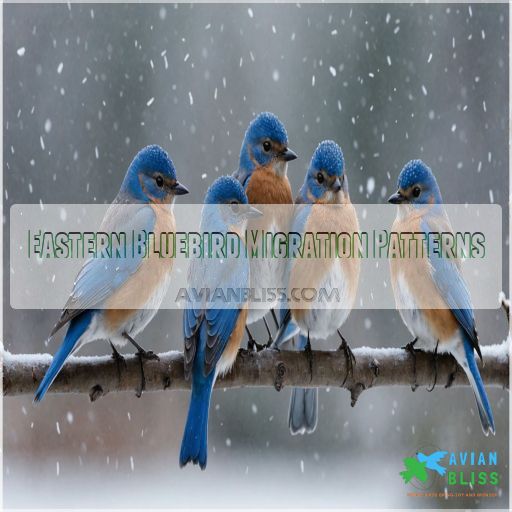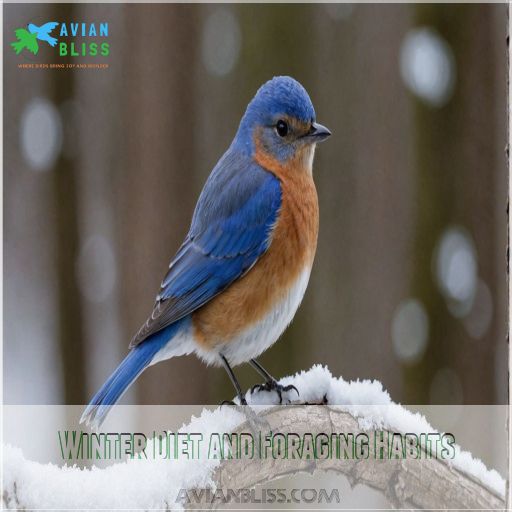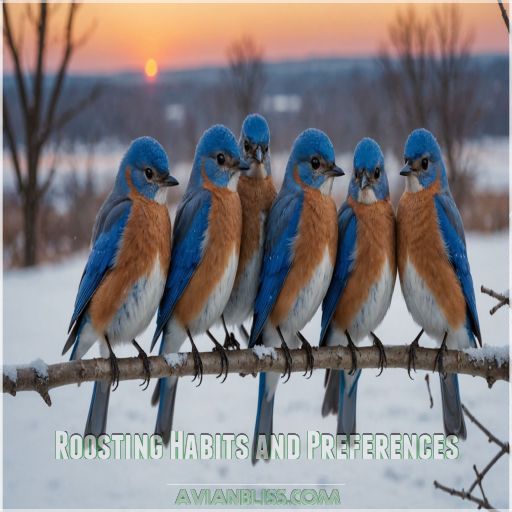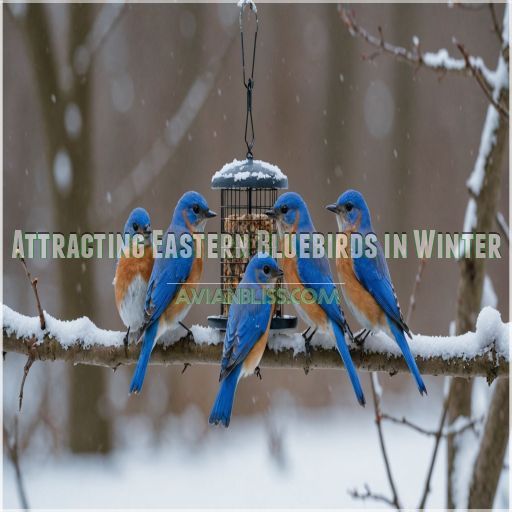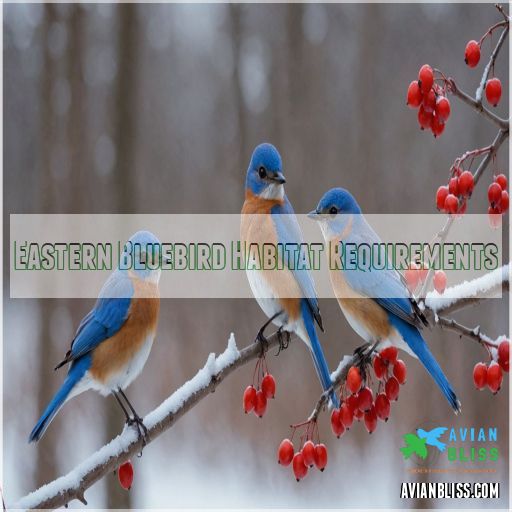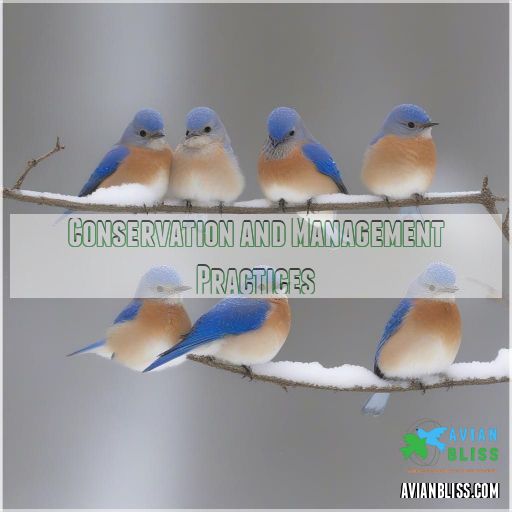This site is supported by our readers. We may earn a commission, at no cost to you, if you purchase through links.
 Eastern Bluebirds, with their vibrant plumage, paint a lively winter scene as they migrate to sunnier states like Texas and Florida, chasing berries as juicy as nature’s candy.
Eastern Bluebirds, with their vibrant plumage, paint a lively winter scene as they migrate to sunnier states like Texas and Florida, chasing berries as juicy as nature’s candy.
They aren’t shy about roosting in tree cavities or even a Purple Martin house for warmth.
You can tempt them with mealworms and a splashy bird bath—think of it as their version of a winter resort.
Avoid lawn chemicals to keep their diet of fruits and berries toxin-free.
These little ones showcase superb winter survival skills, morphing your backyard into their seasonal sanctuary.
Discover how to cozy up to these blues for mutual winter cheer.
Table Of Contents
- Key Takeaways
- Eastern Bluebird Migration Patterns
- Winter Diet and Foraging Habits
- Roosting Habits and Preferences
- Attracting Eastern Bluebirds in Winter
- Eastern Bluebird Habitat Requirements
- Conservation and Management Practices
- General Biology and Ecology
- Frequently Asked Questions (FAQs)
- Where do bluebirds roost in winter?
- What do eastern bluebirds eat during the winter?
- How do you attract eastern bluebirds in the winter?
- Do eastern bluebirds migrate for the winter?
- How do Eastern Bluebirds communicate during winter?
- Can bluebirds recognize individual humans in winter?
- What factors influence bluebird plumage brightness?
- How do bluebirds interact with other bird species in winter?
- What navigational tools do bluebirds use during migration?
- Conclusion
Key Takeaways
- Roll Out the Red Carpet: Want eastern bluebirds visiting your backyard this winter? Sprinkle mealworms around like tasty bird confetti and plant some berry-bearing shrubs—think of it as setting up a five-star buffet for these feathered diners. Keeping it chemical-free boosts your yard’s charm, too!
- Nesting Boxes Are Gold: Providing cozy nesting boxes can turn your yard into the cool new hangout spot for bluebirds like those in Georgia. Make sure they’re in sunny spots, not too hot like an unbearable mid-summer sunbake, and away from predators. A little maintenance ensures their roost resorts are always open for business.
- Every Bluebird Needs a Good Bath: Picture this—a bluebird bath with gently moving water, a spa retreat that keeps your feathered friends’ spirits high. Place it somewhere sunny to keep the icy grip of winter at bay, and revel in their delighted splashes, a sure sign your habitat rocks!
- Respect Nature’s Nuances: Keeping your backyard filled with native trees and shrubs is like offering up the best real estate. These natural havens provide both food and shelter, making you not just a gardener but nature’s perfect host. It’s a win-win, keeping the bluebirds and your garden buzzing with life.
Eastern Bluebird Migration Patterns
Discover the fascinating journey of Eastern Bluebirds as they shift from year-round residents in many areas to seasonal travelers heading to the southern states.
Don’t be surprised if you spot a long-distance traveler from Canada sharing your holiday season or a situational migrant dodging a winter storm for sunnier climes.
Year-Round Residents in Most of Their Range
Eastern Bluebirds know how to thrive, being year-round residents in much of their range.
With these cheerful buddies, breeding success thrives as they defend their cozy habitats.
Winter survival? It’s a breeze if they manage their habitat preferences wisely.
These charming, royal-blue dynamos demonstrate population dynamics.
Their winter migration might be nonexistent, but their adaptability shines all year.
Seasonal Migration to and From the Southern States
As the seasons change, some eastern bluebirds set off on a remarkable journey, migrating from their northern breeding grounds to the warmer southern states.
These seasonal travelers head to areas like Texas, Louisiana, and Florida, where they can find an abundance of the fruits and berries that sustain them through the winter months.
Long-Distance Migrants From Canada
Imagine this: long-distance migrants from Canada often journey over 1,400 miles during winter migration to warmer southern grounds. Mighty migrations demand:
- Keen navigation of migration routes.
- Shifting roosting behavior to balance rest.
- Resourceful adaptation to food availability.
- Fierce yet playful competition for cavities.
These bluebird adventures are like nature’s version of “Survivor.”
Situational Migrants and Temporary Movements
Long-distance migrants aren’t the only ones on the move.
Situational migrants, like weather-triggered hitchhikers, temporarily leave their territories seeking winter survival.
Blizzard blues might shift a few hundred miles south as if chasing a food truck.
These eastern bluebird adventurers endure range shifts, adjusting their roosting antics and seeking winter food, ensuring they’re snug until familiar skies beckon them home to their breeding grounds.
Winter Diet and Foraging Habits
When winter hits, bluebirds switch their menu mainly to fruits and berries, treating trees like a buffet.
Keep your lawn chemical-free, and you’ll become their new favorite neighbor as they snack on insects found near the ground.
Mainly Fruits and Berries in Winter
During the winter, Eastern Bluebirds rely heavily on a diet of wild fruits and berries to sustain themselves. These natural food sources provide the essential nutrients and energy bluebirds need to survive the colder months.
To attract bluebirds, consider:
- Planting native trees and shrubs that bear edible fruits
- Avoiding chemical treatments on your lawn that could harm insect populations
- Offering high-quality mealworms as a supplemental food source
Importance of Native Trees and Shrubs
To help Eastern Bluebirds thrive in winter, you’d want to create a buffet of native trees and shrubs in your backyard.
These plants—like red cedar, dogwood, and sumac—are nature’s pantry, providing key food sources.
With a landscape that suits their habitat, you’re not just a gardener but a steward of conservation, aiding their winter survival.
Avoiding Chemical Treatments for Lawns
When considering sustainable landscaping for your lawn, prioritizing organic lawn care is key to a healthy ecosystem. Chemicals impact birds, reducing bluebird food sources.
Try:
- Natural pest control methods.
- Avoiding chemical fertilizers.
- Embracing native plantings.
- Composting for soil health.
- Encouraging biodiversity.
Organic choices create a safe haven for Eastern Bluebirds, supporting their winter migration and diet.
Feeding on Insects Found on or Near the Ground
After steering clear of lawn chemicals, turn your attention to bluebirds’ knack for ground foraging.
With winter migration in play, these resourceful fliers scan the earth for insects amid fallen leaves.
The eastern bluebird’s diet thrives on such bounty, but pesticides and habitat loss can short-change their feast in Eastern North America.
Keep your patch pesticide-free, ensuring insects abound beneath the earth’s surface delights.
Roosting Habits and Preferences
Where do Eastern Bluebirds choose to roost in the winter?
These adaptable birds may tuck into natural cavities, woodpecker holes, or even your backyard birdhouses.
But their roosting habits during migration remain a bit of a mystery.
Natural Cavities, Woodpecker Cavities, or Nesting Boxes
Eastern Bluebirds, those charming feathered fellows, are quite particular about their winter digs.
They roost in natural cavities, woodpecker-made nooks, or cozy nesting boxes.
But aren’t they picky?
Competing in Cavity-ville, they’ve got some serious real estate drama.
Make sure your nesting box design offers snug safety, perfect for dodging winter’s icy grip and crowded cavity competitors.
Freedom’s nest awaits!
Tree Branches as Roosting Sites During Migration
Imagine it’s winter migration, and eastern bluebirds are searching for cozy roosts.
Sometimes, they skip the cavities and opt for a hotel of branches—talk about going off the beaten path!
Choosing the right branch for roosting can be tricky.
Opt for sturdy options to maximize migration safety and minimize predator risks, ensuring peace in this winter escape plan.
Communal Roosting in Single Cavities
Roosting during winter migration? Well, it’s a party! Eastern bluebirds often gather for communal roosting in single cavities, although it comes with its pros and cons.
- Cavity Competition: Choose your roommates wisely, space is tight!
- Roosting Density: Snug as a bug, or bird.
- Social Benefits: Warmth and friendships.
- Disease Risk: Watch out for colds.
Uncertainty About Roosting Sites on Wintering Grounds
While bluebirds often roost communally during migration, their winter roosting habits remain a bit of a mystery.
With cavities in short supply, these feisty birds may face stiff competition from other species.
Their timing of arrival on wintering grounds could impact roost site availability and predation risks.
But with a little creativity, you can provide safe, cozy spots for bluebirds to call home all season long.
Attracting Eastern Bluebirds in Winter
If you want to entice Eastern Bluebirds to visit your backyard this winter, try offering bird baths with moving water and natural treats like mealworms.
You might find these colorful visitors enjoying a cozy night in your nesting boxes, or even turning your Purple Martin houses into a winter retreat.
Bird Baths With Moving Water
When winter bites, offering a bird bath with moving water can make your backyard a haven for Eastern Bluebirds. Why do they love a splash? The gentle flow reminds them of babbling brooks.
- Bird bath design: Shallow with a ramp for easy access.
- Water flow impact: Circulation prevents freezing.
- Bird bath location: Place in a sunny spot.
Providing Mealworms and Natural Foods
Sprinkle mealworms in your backyard to attract Eastern Bluebirds during winter migration.
Although natural foods like berries are their first love, mealworms add a tasty twist to their diet preferences.
Think of it as offering them a five-star restaurant in your garden!
Use a well-designed bird feeder that protects mealworms from rain, ensuring safe and delicious dining for mealworm-loving birds.
Nesting Boxes as Roosts at Night
Nesting boxes can double as cozy overnight retreats for Eastern Bluebirds during the chilly winter months.
Place these snug shelters in sunny spots near your yard’s natural food sources, and you may just spot a few feathered friends roosting there at night, escaping the elements in style.
Just be sure to keep an eye out for any roosting competition from other cavity-nesters.
Purple Martin Houses as Winter Roosts
Think of your backyard as a bluebird Airbnb! Purple Martin houses can double as cozy winter roosts for Eastern Bluebirds, helping them survive the winter.
- Benefits: Provides shelter during migration
- House maintenance: Keep them clean and accessible
- Bluebird competition: Deter starlings
- Martin house design: Ensure ample entrance and space
Join the North American Bluebird Society for tips!
Eastern Bluebird Habitat Requirements
To make Eastern Bluebirds feel at home, your yard should have open areas with scattered trees and shrubs, resembling nature’s finest golf course.
Add a dash of sunlight with nest boxes in sunny spots, and you’ll have bluebirds as delighted as kids spotting candy on Halloween!
Open Areas With Scattered Trees and Shrubs
Choosing prime real estate, Eastern Bluebirds thrive where scattered trees and shrubs pepper the landscape like sprinkles on a cupcake. This habitat selection offers an open land ideal for foraging behavior. Tree spacing makes it easy for them to migrate in the winter and roost.
Shrubs provide security—akin to fortresses foraging bluebirds depend on—where they feast without feeling like someone’s lunch.
Grasslands, Fields, and Golf Courses
You’ll often spot Eastern Bluebirds perched atop fence posts or telephone wires in open grasslands, fields, and even golf courses.
These habitats provide the perfect mix of scattered trees, shrubs, and short vegetation for bluebirds to thrive.
To attract them, maintain:
- Diverse native plant life
- Minimal pesticide use
- Ample perching spots
Large Trees or Nest Boxes
Eastern Bluebirds aren’t just picky decorators, they’re savvy real estate agents! They use large trees or nest boxes for shelter.
Here’s a quick look at what they need:
| Habitat Feature | Importance |
|---|---|
| Large Trees | Natural roosting sites |
| Nest Boxes | Alternative to natural cavities |
| Nesting Material | Comfort and protection |
| Bluebird Competition | Access to prime spots |
| Predator Threats | Safety from potential danger |
Think of large trees as elegant condos! They are essential Natural roosting sites, providing the necessary Safety from potential danger.
Sunny Locations for Nesting Boxes
Getting nesting boxes for bluebirds is great, but location’s key! Sun exposure is important—imagine your box basking in the morning sun, like a bird’s version of a cozy café. Avoid the afternoon heat to prevent sweaty feathered tenants.
Make sure boxes are safe from predator threats for better nesting success.
Your bluebird habitat is a prime winter migration and roosting spot!
Conservation and Management Practices
You can make a big difference in helping Eastern Bluebirds by providing nesting boxes and avoiding harmful chemicals like pesticides.
Supporting conservation groups and leaving some of those "old, dead-looking" trees up in your yard can give these beautiful birds the safe spaces they need.
Providing Nesting Boxes and Food Sources
Providing nesting boxes and natural food sources is key to supporting eastern bluebirds during the winter months.
Place boxes in sunny locations near open areas with scattered trees and shrubs – bluebirds love perching on nearby branches.
Offer a variety of native berries, fruits, and mealworms to supplement their diet.
These small gestures can make a big difference!
- Strategically position nesting boxes for maximum visibility and accessibility
- Fill feeders with a mix of high-energy berries, fruits, and mealworms
- Maintain a chemical-free yard to preserve the insects bluebirds rely on
- Incorporate native plants that provide shelter and sustenance year-round
Avoiding Pesticides and Herbicides
When crafting a safe haven for eastern bluebirds, skip the pesticides—go green!
By embracing organic lawn care, you’re ensuring bluebird safety during their winter migration.
Natural pest control keeps harmful chemicals at bay.
| Chemical Alternatives | Benefit | Eco-friendly Methods |
|---|---|---|
| Vinegar Solutions | Weed Control | Compost Tea |
| Neem Oil | Insect Repellent | Companion Planting |
| Diatomaceous Earth | Pest Deterrent | Ladybug Release |
Think of it as sustainable gardening with heart!
Supporting Organizations for Conservation
Put your money where your birds are: support bluebird conservation groups and habitat restoration projects. It’s as fulfilling as finding an extra fry at the bottom of the bag!
By joining nest box programs and citizen science projects, you aid the eastern bluebird’s winter migration, diet, and roosting needs.
These initiatives rely on funding to keep thriving.
Retaining Snags and Trees in Clear-cuts
You’d be surprised at the hidden gems in a forest—snags. These standing dead trees boost biodiversity and are essential for Eastern Bluebird winter migration.
Keep them during clear-cut management to:
- Enhance wildlife habitat
- Foster forest health
- Embrace nature’s quirks
Think of snags as nature’s version of a bed-and-breakfast: cozy, safe, and never dull!
General Biology and Ecology
The Eastern Bluebird is a fascinating member of the Thrush family, with its striking blue plumage and distinctive behaviors.
From their ground-foraging habits to their vertical posture and abrupt flight, these birds captivate birdwatchers with their charming presence.
Scientific Classification and Family
In the grand tapestry of bird taxonomy, Eastern Bluebirds find their place in the Thrushes family, Turdidae order.
Imagine a family reunion with diverse cousins—each one sings its own shiny song.
Eastern bluebirds, with their bold blues and rusty reds, steal the spotlight.
This table summarizes their classification:
| Common Name | Scientific Name | Order |
|---|---|---|
| Eastern Bluebird | Sialia sialis | Turdidae |
| Hermit Thrush | Catharus guttatus | Turdidae |
| American Robin | Turdus migratorius | Turdidae |
| Wood Thrush | Hylocichla mustelina | Turdidae |
| Veery | Catharus fuscescens | Turdidae |
Ah, those family dynamics! They’re quite the melodious sitcom.
Ground Foraging and Perching Habits
Building on their scientific classification, Eastern Bluebirds are agile acrobats in ground foraging.
With keen eyes, they select prey like insects scuttling in open terrains.
Their perching habits are a masterclass in predator avoidance – like performers on a tightrope, they perch on power lines, scanning for danger.
These birds thrive in diverse habitats, ensuring their survival through winter’s challenges.
Vertical Posture and Abrupt Flight
Ever notice an Eastern Bluebird’s vertical posture and abrupt flight? This isn’t just for show; it’s a clever survival move! Like ninja warriors of the bird world, they:
- Scan ground for prey with precision.
- Launch swiftly to deter predators.
- Swoop down with pinpoint accuracy.
- Return to perch to repeat the process.
It’s all about mastering their flight patterns!
Mating and Breeding Behaviors
Male Eastern Bluebirds put on quite a show to attract mates, waving their wings and bringing nest material to the cavity.
Once paired, the female does all the nest-building and incubating, though both parents care for the young.
Larger broods are more common in northern and western populations, giving these resilient birds the best chance at survival.
Frequently Asked Questions (FAQs)
Where do bluebirds roost in winter?
Ah, the age-old mystery of where our feathered friends lay their heads at night!
Fear not, my friend, for bluebirds are quite the savvy roosters.
They snuggle up in cozy tree cavities, nesting boxes, and even the occasional abandoned woodpecker hole.
Sweet dreams, little blue wonders!
What do eastern bluebirds eat during the winter?
In winter, Eastern Bluebirds shift their diets to fruits and berries, munching on nature’s sweet snacks like red cedar and dogwood berries.
This fruity feast helps them stay fueled and fantastic during the chilly months.
How do you attract eastern bluebirds in the winter?
Want bluebirds flocking to your winter yard?
Roll out the red carpet with native fruit trees like dogwood and red cedar.
Skip lawn chemicals and let those mealworms squirm.
Remember, a splashy birdbath steals the show!
Do eastern bluebirds migrate for the winter?
Why, yes, some eastern bluebirds do migrate southwards in winter to escape harsh conditions.
While some journey over 1,400 miles, others stick around, staying put with local birds, making migration a real mixed-bag adventure!
How do Eastern Bluebirds communicate during winter?
Imagine the Eastern Bluebird’s winter symphony – a melodic exchange of chirps and trills, a feathered language that guides them through the colder months.
Their voices carry the warmth of community, a harmonious dance in the frosty air.
Can bluebirds recognize individual humans in winter?
Eastern Bluebirds might not recognize individual humans, but they often become accustomed to people’s routines, associating them with food or safety.
This familiarity can lead to heartwarming encounters, especially at feeders, during the cold months (Source).
What factors influence bluebird plumage brightness?
Wind, weather, and whimsy might influence a bluebird’s plumage brightness. You’ll find it affected by diet, environmental pressure, and social conditions, enhancing visual appeal for mating or territorial dominance (Source).
How do bluebirds interact with other bird species in winter?
Did you know bluebirds travel up to 1,400 miles for winter?
They compete for roosting spots with starlings and sparrows.
It’s a bit like musical chairs—dance, adapt, and grab a safe spot!
What navigational tools do bluebirds use during migration?
You’d be amazed by the navigational tools bluebirds use during migration!
They rely on the sun, stars, and Earth’s magnetic field to find their way, using an internal compass to guide them.
Pretty neat, right?
Conclusion
Did you know that 80% of Eastern Bluebirds return to their previous winter spots? This connection to familiar territories makes it easier for you to help them during their winter stay.
By understanding the Eastern Bluebirds’ winter migration, diet, and roosting habits, you can transform your yard into a welcoming haven.
Offer mealworms, install nesting boxes, and avoid lawn chemicals to make sure they’ve a safe and cozy environment, enhancing both their survival skills and your backyard’s charm.

